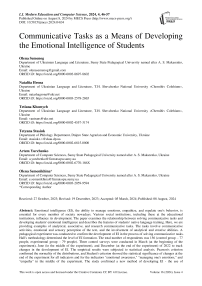Communicative Tasks as a Means of Developing the Emotional Intelligence of Students
Автор: Olena Semenog, Nataliia Hrona, Tetiana Khomych, Tetyana Stasiuk, Artem Yurchenko, Olena Semenikhina
Журнал: International Journal of Modern Education and Computer Science @ijmecs
Статья в выпуске: 4 vol.16, 2024 года.
Бесплатный доступ
Emotional intelligence (EI), the ability to manage emotions, empathize, and regulate one's behavior, is essential for every member of society nowadays. Various social institutions, including these at the educational institutions, influence its development. The paper examines the relationship between solving communicative tasks and developing students' emotional intelligence and describes the features of students' native language training. Here, we are providing examples of analytical, associative, and research communicative tasks. The tasks involve communicative activities, emotional and sensory perception of the text, and the involvement of analytical and creative abilities. A pedagogical experiment was conducted to confirm the development of EI in the process of solving communicative tasks. Hall's methodology determined the level of EI formation. The total number of respondents was 156 (control group – 77 people, experimental group – 79 people). Three control surveys were conducted in March (at the beginning of the experiment), June (in the middle of the experiment), and December (at the end of the experiment) of 2022 to track changes in the development of EI. The empirical results were subjected to statistical analysis. Pearson's criterion confirmed the normality of the distributions, and Student's criterion showed the statistical significance of changes at the end of the experiment for all indicators and for the indicators "emotional awareness," "managing one's emotions," and "empathy" in the middle of the experiment. The study confirmed a new method of developing EI - the use of communicative tasks in teaching the native language, which extends the existing research results on the development of EI in learning foreign languages. The study lays grounds for several conclusions, including that solving communicative tasks may model "life situations" and indirectly form models of the future behavior of young people. It also identifies an urgent need for special courses for teachers on developing skills to create communicative tasks; it is essential to modernize teacher training programs, which should include the development of skills to model situational emotionally colored tasks that do not have an unambiguous answer and require analysis, comparisons, and evaluations.
Emotional intelligence, communicative tasks, communicative approach, professional training, teacher training, educational process
Короткий адрес: https://sciup.org/15019178
IDR: 15019178 | DOI: 10.5815/ijmecs.2024.04.04
Текст научной статьи Communicative Tasks as a Means of Developing the Emotional Intelligence of Students
It is impossible to imagine a society without communication processes. Speech and written text become the primary tools for communication and expression of emotions. The recognized emotion can affect the balance of a reaction or the correctness of a decision. For this reason, research on human emotional intelligence (EI) gained crucial importance. EI is identified as a person's ability to recognize and manage emotions, perceive the emotional state of others, empathize, and regulate their thoughts and behavior. Ukrainian students study in a time of war. Classes often become a source of balancing emotions, maintaining calm, and transforming students' adverse reactions into positive ones. Teachers must form the students' behavior model and promote their emotional stability and resilience. Native language communication can become a tool for such formation, positively impacting emotional state and personality development. Therefore, the problem of developing students' emotional intelligence in teaching and communication needs to be researched.
2. Analysis of the Current Research
EI is defined through a combination of emotional abilities and meta-emotional dimensions [1] or as a symbiosis of "personal characteristics intelligence; intelligence competence; instrumental, reflexive intelligence" [2]. The study [3] suggests that if people understand their emotions and those of others, they realize how to act and model the behavior reaction. On the other hand, scientists link EI to human cognitive abilities [4] and argue that EI can develop in learning. In particular, the connection between flexibility in industrial training and EI [5], as well as the use of problem-based learning technologies [6], socio-emotional [7], productive [8], and inclusive learning [9], and the development of students' EI has been proven.
Several studies confirm the connection between EI and teaching various disciplines. In the paper [10], the connection between EI and foreign language learning was confirmed: "Emotional intelligence was significantly correlated with language learning strategies and learning styles." The paper [11] confirms the results of more developed empathy, self-motivation, and control of one's behavior through emotion management. The paper [12] proves the direct link between EI and the desire to communicate. The dependence on EI and music education is confirmed in the articles [13, 14]: researchers confirm the connection between music education and the intellectual abilities of young people. Also, the paper [15] confirms the link between EI and math learning outcomes.
The analysis of scientific papers presented in [12] has shown that communication is a tool for developing EI. The term "communication" (from the Latin "communico") characterizes human interaction [16]. With the help of language, the world is cognized, and knowledge about it is formed. A personality and worldview are formed in communication (speech and communication). Communication as a 21st-century skill is focused on information exchange [17]. Communicative can be verbal and non-verbal (formulate and transmit information, but also perceive information) [18]. Communication is characterized by a person's ability to speak, write, and use the communication system [19] and the system of social skills (how to behave in society, communicate with others, to understand the intentions of others) [20] correctly. The ability to communicate is naturally formed in direct communication. In the educational process, this is facilitated by communicative tasks that involve interactive interaction. Communicative tasks are designed to strengthen the practical orientation of education and to form or develop communicative skills in various spheres of social life [21]. The authors of [22] argue that understanding what students read or hear depends on their emotions. Emotions become the driving force of communication - you need to share to express yourself.
Thus, the generalization of scientific results shows that: EI is characterized as the ability to understand and manage emotions; EI can be developed in the learning process; Communication in the native language gives the possibility to characterize the emotional state correctly; Situation analysis is a tool for modeling people's reactions and using it in the future. These conclusions allow us to assume the development of EI in analyzing different real situations, which are described in communicative tasks.
Thus, the paper aims to study the development of EI in solving communicative tasks.
3. Methodology
Achieving the goal involved solving two tasks:
-
1) to describe the creation and use of communicative tasks in native language learning;
-
2) to study the connection between EI and solving communicative tasks.
To solve the first task, we created different communicative tasks. The tasks included students in active, communicative activities, requiring emotional perception of the text and using analytical and creative skills to solve various situations (the description of communicative tasks is given below).
We used surveys and statistical methods to solve the second task of the study. The definition of EI is possible based on various methods [23]: Bar-On Emotional Intelligence Inventory test, Emotional Quotient Inventory, Trait Emotional Intelligence Questionnaire, Mayer-Salovey-Caruso Emotional Intelligence Test, etc. Called methods investigate specific characteristics of EI: expression of emotions, regulation of emotions, internal and external emotional satisfaction, and others. We chose Hall's method for the definition of EI [24], which is based on assessing the development of five parameters of EI: emotional awareness (parameter 1), management of one's emotions (parameter 2), self-motivation (parameter 3), empathy (parameter 4), and recognition of the emotions of others (parameter 5). The test includes 30 statements. Each respondent received a form (Table 1) in which it was necessary to put a corresponding mark against each statement: "disagree at all (-3 points)", "disagree mostly (-2 points)", "disagree partially (-1 point)", "partially agree (+1 point)", "agree mostly (+2 points)", "agree in general (+3 points)".
Table 1. Test for the determination of EI (after Hall's method)
|
No |
Statement |
Points (degree of agreement) |
|||||
|
-3 |
-2 |
-1 |
+1 |
+2 |
+3 |
||
|
1. |
Negative and positive emotions are a source of knowledge for me about life decisions. |
||||||
|
2. |
Negative emotions help me realize what I need to change in my life. |
||||||
|
3. |
I am calm when I feel like I am under pressure. |
||||||
|
4. |
I feel a change in my feelings. |
||||||
|
5. |
I am calm and focused in order to act on the situation. |
||||||
|
6. |
I can evoke positive emotions, particularly joy, inner positivity, and humor when necessary. |
||||||
|
7. |
I am capable of feeling and being aware of an emotional state. |
||||||
|
8. |
I can quickly deal with my feelings despite the sad news. |
||||||
|
9. |
I can listen to other people's problems. |
||||||
|
10. |
I do not focus on negative emotions. |
||||||
|
11. |
I am sensitive to the emotional needs of others. |
||||||
|
12. |
I am capable of calming other people. |
||||||
|
13. |
I can force myself to overcome obstacles over and over again. |
||||||
|
14. |
I am capable of creatively solving life's problems. |
||||||
|
15. |
I respond adequately to the moods, actions, and desires of others. |
||||||
|
16. |
I quickly enter a state of calm and concentration. |
||||||
|
17. |
I analyze my negative feelings and am aware of their appearance in my free time. |
||||||
|
18. |
I can calm down quickly after unexpected sad (annoying) information. |
||||||
|
19. |
I am aware of my feelings to maintain a "good emotional shape." |
||||||
|
20. |
I understand other people's emotions well, even if they hide them. |
||||||
|
21. |
I can recognize emotions through facial expressions. |
||||||
|
22. |
I can easily dismiss negative emotions when I need to act. |
||||||
|
23. |
I have a good understanding of non-verbal signs in communication. |
||||||
|
24. |
I am well aware of the state of nervous elation tension of other people. |
||||||
|
25. |
People who are aware of their feelings act logically. |
||||||
|
26. |
I can improve other people's moods. |
||||||
|
27. |
I can advise about human relationships. |
||||||
|
28. |
I am good at attuning to others' emotions. |
||||||
|
29. |
I help others to use their desires to realize their personal life positions. |
||||||
|
30. |
I can quickly shift my attention from worries to something else. |
||||||
The N. Hall test allows us to determine the development of EI according to five parameters:
-
(1) "Emotional awareness" (Table 1, items 1, 2, 4, 17, 19, 25) characterizes a person's ability to realize and understand their own emotions, to analyze their internal state;
-
(2) "Managing one's emotions" (Table 1, items 3, 7, 8, 10, 18, 30) characterizes emotional flexibility, the ability to voluntarily manage emotions;
-
(3) "Self-motivation" (Table 1, items 5, 6, 13, 14, 16, 22) characterizes the management of one's behavior through the conscious management of emotions;
-
(4) "Empathy" (Table 1, items 9, 11, 20, 21, 23, 28) characterizes the understanding of other people's emotions, the ability to empathize, as well as the willingness to support and understand the state of a person ("someone else's position");
-
(5) "Recognition of the emotions of others" (Table 1, items 12, 15, 24, 26, 27, 29) characterizes the ability to influence the emotional state of one's environment.
The sum of points is calculated considering the signs (+ or –) for each parameter that defines the EI-level: 14 and more – high level of EI; 8-13 – average level of EI; 7 or less – low EI.
The research model is presented in Fig. 1.

Fig. 1. Research Model
Students from different educational institutions took part in the pedagogical experiment (Fig. 2).



Specialized College of Transport and Computer Technologies of Chernihiv Polytechnic University
Prylutskv
Humanitarian - Ivan Franko Pedagogical College of the Chernihiv Regional Council
Makarenko Sumy State Pedagogical University
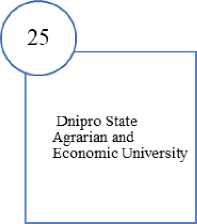
Fig. 2. Participants of the pedagogical experiment
The total number of respondents was 156 people (control group (CG) – 77 people, experimental group (EG) – 79 people). Eleven teachers of the Ukrainian language took part in the pedagogical experiment. In the CG, the teaching of the native language has not changed. Two or three communicative tasks were offered at each lesson in the EG.
The experiment lasted from March to December 2022. All participants were familiar with the conditions of the experiential training and did not deny their participation in it. The survey was conducted anonymously. To track changes in the development of EI, we had three control surveys during March (at the beginning of the experiment), June (in the middle of the experiment), and December (at the end of the experiment) in 2022.
Empirical results were subjected to statistical analysis: Pearson's test to confirm the normality of the distributions of EI levels in groups and the Student's criterion for estimating averages separately for each parameter.
After the second and third surveys, a qualitative analysis of the results took place – we interviewed teachers and students to find out their subjective opinions on the development of their ability to manage their own emotions. The questions (Table 2) were developed by the teachers who agreed to participate in the experiment.
Table 2. Interview Questions
|
No |
Questions |
|
1. |
Assess your anxiety level during February-December 2022 |
|
2. |
Did you desire to participate in the educational process? |
|
3. |
Could you be able to control your emotions? |
|
4. |
Did you feel motivated to study? |
|
5. |
Was empathy important for students? |
|
6. |
Did the emotion of anger motivate you to take action? |
|
7. |
What helped at different stages of learning? |
|
8. |
Is it possible to understand with the help of a particular emotion what a person thinks, feels about the situation, and feels about others? |
|
9. |
How satisfied are you with the level of communication with teachers? Is it necessary? |
The experts (three Ph. D.s in psychology with at least ten years of professional experience) gave an upbeat questionnaire assessment. The processing of the results involved the systematization of answers and their generalization.
4. Results 4.1 Describing the use of communicative tasks
Communication is essential for the development of EI, so working with text has become the basis for the development of communicative tasks that describe real-life situations. The tasks were supposed to actualize the internal perception of the described situation. It was essential to hear the students' thoughts and understand their feelings about the specific situations described in the task. We assumed that interpreting situations in tasks would encourage students to turn to linguistic means of expressing a state or emotions. Therefore, we considered it expedient to use tasks involving analyzing the situation, comparing and arguing views, evaluating facts, etc. We referred to such tasks as communicative tasks of the analytical type. The tasks were both based on ready-made texts (examples of questions are given in Fig. 3) and events (fiction or real) that happened to the student but were not recorded and therefore required an additional description of the situations and then their analysis or evaluation (Fig. 4).

What phrases express complaint? What can be comforting phrases in this situation?
Fig. 3. Questions used in analytical tasks for a specially selected text
Comment on the content of the expressive series of synonyms. What content do they convey? Ate they located in the dir ection of increasing or decreasing emotional impact?
Find phr ases in the text that convey surprise.
Read a passage from the poem and indicate contextual synonyms. What emotion do they convey?
Think back to your failure situation. Tell us how you behaved. Describe or write that story (thesis-argument-example-conclusion)

Write an essay on a given problem (e.g., "best learning mistakes")
Fig. 4. Analytical-type tasks for situations (fiction or real)
In language learning, first, it is essential to create a motive, that is, to put the student in a situation where he would have a need and desire to join the conversation. To do this, you need a goal: to learn something, to inform, to encourage someone to act, to express emotions). Therefore, we used tasks that do not require so much analysis as associative thinking, perception of the positions of the majority, etc. We referred to such tasks as associative tasks (Fig. 5).
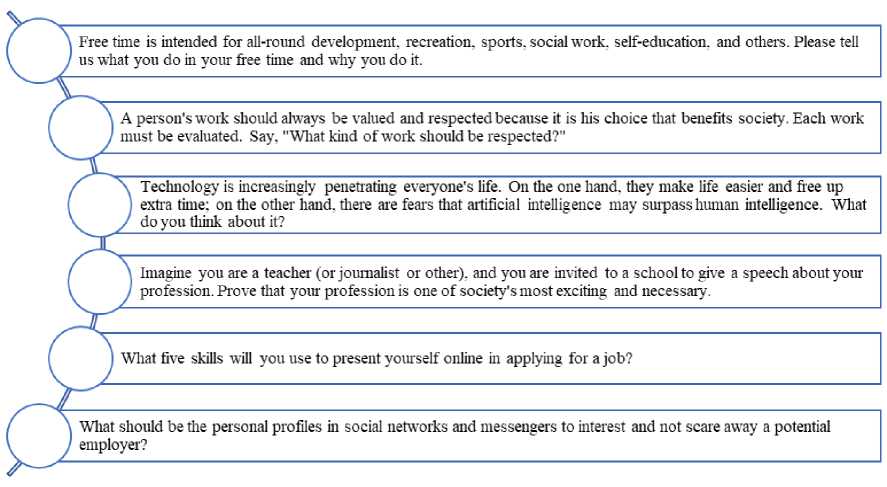
Freetime is intended for all-round development, recreation, sports, social work, self-education, and others. Please tell us what you do in your free time and why you do it.
Technology is increasingly penetrating everyone's life. On the one hand, they make life easier and flee up extra time: on the other hand, there are fears that artificial intelligence may surpass human intelligence. What do you think about it?
What should be the personal profiles in social networks and messengers to interest and not scare away a potential employer?
A person's work should always be valued and respected because it is his choice that benefits society. Each work must be evaluated. Say. "What kind of work should be respected?"
What five skills will you use to present yourself online in applying for a job?
Imagine you ar e a teacher (or journalist or other), and you are invited to a school to give a speech about your profession. Prove that your profession is one of society's most exciting and necessary.
Fig. 5. Communicative tasks of associative type
Another type of communicative task is research. These tasks required imagining oneself as someone and describing one's actions. These tasks required students to identify creative abilities and imagine themselves in a different role (Fig. 6).

Fig. 6. Communicative tasks of research type
Thus, the experimental teaching of the native language was based on communicative tasks of analytical, associative, and research types. The tasks involved the involvement of students in active, communicative activities, required emotional and sensory perception of the text, and the involvement of analytical and creative abilities in solving various situations.
-
4.2 Statistical Analysis of Data
We conducted three surveys to quantify the level of emotional intelligence in different periods of native language learning. The results of these surveys are presented in diagrams (Fig. 7).
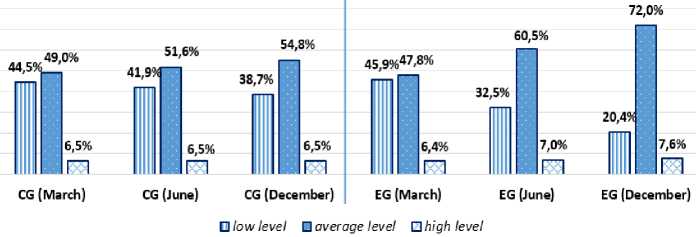
(a) Emotional awareness
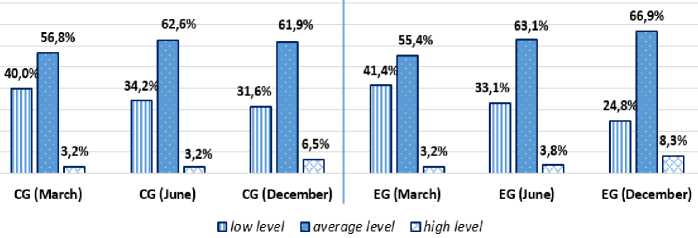
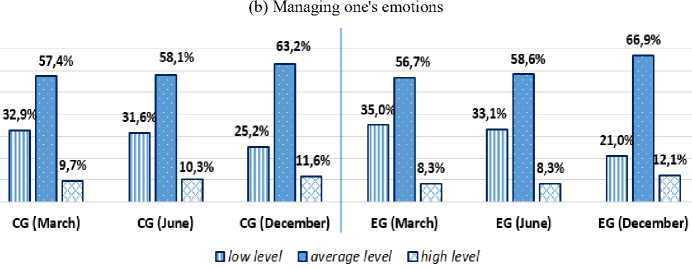
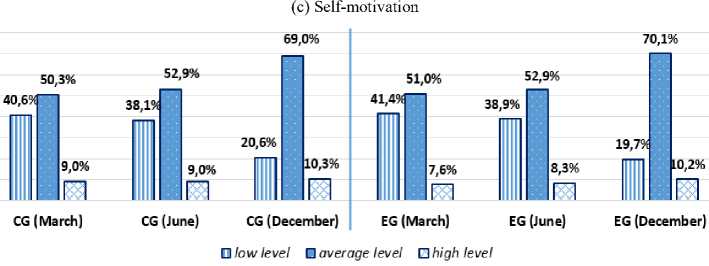

(e) Recognition of the emotions of others
Fig. 7 (a-e). Diagrams of the distribution of EI levels in CG and EG
Statistical analysis of the distributions according to Pearson's criterion confirmed their normality at the significance level of 0.05, and the analysis of the means according to the Student's criterion showed the statistical significance of changes at the end of the experiment for all parameters 1-5 and for parameter 1 "emotional awareness," parameter 3 "managing one's emotions," parameter 4 "empathy" in the middle of the experiment (Table 3, Bold cells).
At the beginning of the pedagogical experiment, the normality of the distribution of EI levels in the CG and EG groups and the statistical equality of the averages in the CG and EG groups was confirmed. According to the analysis of the presented results in the middle of the experiment, we observe a statistically significant increase in the parameters of "emotional awareness," "management of one's emotions," and "empathy." The results in December showed an increase in the level of EI on all parameters and statistically more to CG.
Table 3. Statistical indicators*
|
Period |
Statistical indicators |
Parameter 1 |
Parameter 2 |
Parameter 3 |
Parameter 4 |
Parameter 5 |
|
March |
Average CG |
7.3 |
7.7 |
8.6 |
8.0 |
7.7 |
|
Average EG |
7.4 |
7.6 |
8.7 |
7.9 |
7.6 |
|
|
Student's Meaning |
0.7 |
0.5 |
0.5 |
0.6 |
0.5 |
|
|
June |
Average CG |
7.8 |
8.1 |
8.9 |
8.5 |
8.1 |
|
Average EG |
8.6 |
8.4 |
9.9 |
9.4 |
8.5 |
|
|
Student's Meaning |
2 |
1.8 |
2.1 |
2.2 |
1.6 |
|
|
December |
Average CG |
8.5 |
10.2 |
10.0 |
10.0 |
9.7 |
|
Average EG |
10.1 |
11.5 |
11.3 |
12.3 |
11.2 |
|
|
Student's Meaning |
2.5 |
3.2 |
3.1 |
4.1 |
3.4 |
*According to the Student's criterion (H0: the means in the groups are statistically equal). The critical value of 1.97 for a significance level of
0.05.
Also, teachers and students were interviewed after the second and third surveys. Systematization of the answers made it possible to summarize them in a table (Table 4).
Table 4. Summary of interview results
|
Question |
Generalized answers |
|
Assess your anxiety level during February-December 2022 |
Some answers: I was anxious today (30%); I was anxious a lot (60%); I was calm but periodically felt anxious (20%). |
|
Did you desire to participate in the educational process? |
There was no ambiguity in the answers: students just wanted to communicate, share information, and discuss what they read (many began to read Ukrainian fiction content). Students began to read the news and critically evaluated it. They began to filter the fakes. In September, some students participated in competitions (writing essays), expressed a desire to communicate with the teacher, and discussed the content of language tasks. |
|
Could you be able to control your emotions? |
Initially, students were interested in their emotions (70%). In September-December, they began to understand the emotions of others more deeply, learned to comfort (calm others), tell life or war stories, and analyze the emotional state of all parties. |
|
Did you feel motivated to study? |
The level of students' self-motivation grew, but in the summer, it stopped. We suggest that there was a break in teaching the native language. |
|
Was empathy important for students? |
The number of those who tried to argue the opposite position, accepting it as their own (students put themselves in the place of another one), has increased. Therefore, students began understanding emotions better, paying attention to details, and looking for more profound arguments for their answers. |
|
Did the emotion of anger motivate you to take action? |
The answers included actions for achieving personal goals, actions to protect oneself and others (volunteering, donations), reading books, in particular, "Audiobooks in Ukrainian" (65% of respondents have subscribed, and the number of subscribers to the Telegram channel "Ukrainian Language" (the most significant channel for learning the Ukrainian language) has increased to 70%) |
|
What helped at different stages of learning? |
When unpleasant experiences arose, delicious food (21%), music (19%), walks (15%), and communication (45%) helped. |
|
Is it possible to understand with the help of a particular emotion what a person thinks, feels about the situation, and feels about others? |
50% agreed. Students noted that when a person becomes emotionally stable, it allows him to learn not to show his mood to others, not to make his inner world so transparent, and to open only that part of his thoughts permissible in a particular situation. That helps maintain emotional and mental health. |
|
How satisfied are you with the level of communication with teachers? Is it necessary? |
Students would like more communication, including in the process of solving communicative tasks, but such communication was needed not only for the sake of assessment. |
5. Discussion
Our study confirmed the hypothesis that EI evolves in solving communicative tasks. So, the study confirmed a new method of developing EI - the use of communicative tasks in native language teaching, which extends the existing research results on the development of EI in foreign language learning. The described approach to EI development has been implemented in several Ukrainian educational institutions. In native language teaching, we used different types of communicative tasks, encouraging students to express themselves, discuss possible reactions to situations, and realize the consequences of their decisions. This approach, on the one hand, ensured the development of the ability to speak and write in the native language and, on the other hand, the development of empathy, emotional awareness, selfmotivation, the ability to manage their emotions and recognize the feelings of others people through describing their emotional states, assessing the reactions, and making predictions about their behavior in future.
Our research aligns with the ideas of forming 21st-century skills, which include creativity, critical thinking, collaboration, and communication. The last three skills are related to human EI. In the review [25], the authors assess the success of the formation of EI at the individual and institutional levels. Creativity development is often associated with brainstorming techniques [26, 27] and methods of designing and researching ideas [28, 29].
The researchers' conclusion provides the basis for developing communicative tasks that require a creative approach, discussion, and selection of the best idea. We have implemented this in research-type communicative tasks. Institutional support for developing critical thinking skills is discussed in [30]. The authors emphasize the importance of teaching rhetoric and developing the ability to speak, argue, and evaluate information. In [31], the authors discuss the possibility and necessity of forming media and information skills through working with text. Paper [32] notes the practicality of using specific examples and exercises that require general and abstract thinking. The generalization of the results of these studies also suggests the practicality of using analytical and associative type communicative tasks to develop critical thinking. We used the conclusions of the article [33] about the relationship between EI and analytical skills, as well as the conclusions of the article [34] about the dependence on EI from critical thinking. The researchers state, "EI may be the underlying mechanism for achieving critical thinking." This conclusion does not contradict our results: solving analytical and associative communicative tasks and using high-level thinking skills are interrelated. Solving communicative tasks ensures the gradual development of thinking skills.
Solving communicative tasks is a strategy for native language teaching, which is based on communication (oral and written). That strategy additionally prepares young people for solving problems through communication. We define a situation in a communicative task (according to [35]) as a set of external conditions and internal (emotional) states of communicators. Therefore, we tried to increase the emotionality of the communicative tasks in the process of selecting or creating those tasks. At the same time, we used national particularity, typical situations from life, provocativeness of situations, debatability, possibility of multiple solutions, etc. We understood the importance of modeling an actual situation through the peculiarities of its presentation in the textual condition: it is important to immerse the students in the "real situation" and teach them to navigate it (to image the interlocutor, predict possible answers, etc.) [33].
We considered that EI is related to the ability to analyze emotions. Therefore, we formed an "experience" of solving communicative tasks by discussing real situations. They evoke emotions, make us aware of other people's emotions, and analyze these processes. Such a vision of emotion analysis is presented in [36] – the authors used emotional knowledge to improve thinking processes. Since individuals with high EI can successfully influence society and achieve high labor productivity by regulating their emotions [37], the development of EI is essential during learning in educational institutions [38]. The paper [39] confirms the connection between students' emotional instability in the educational environment and the practice of controlled stress (emotion management): "The correct management of emotions in stressful situations could promote effective learning through enhanced attention and ability to solve problems." That aligns with our study's idea – to improve EI by solving communicative tasks involving comprehension and analyzing various situations that can provoke stress. With the help of communicative tasks, students learn to manage their own emotions. Communicative tasks that describe a stressful situation develop the ability to be aware of feelings and perceive situations more balanced and calm.
In solving communicative tasks, we used group forms of work. EI, as a combination of intelligence and emotions, determines human reactions and influences the perception of emotions and their management [40]. It provides the basis for correcting emotions in group communicative task-solving. That further confirmed that EI can significantly impact the team's overall effectiveness [41], and individual EI can be combined into group EI. Group emotions can regulate the emotional state of individual team members [42]. Solving communicative tasks in a group enhances empathy, makes it possible to improve and stabilize the members' emotional state, not make spontaneous decisions, and manage emotions productively inside the group.
6. Conclusion
The study draws several conclusions.
The educational sector is an institution that focuses on the development of society as a whole and prepares young people for life there. Education should consider the needs of the younger generation in intellectual and emotional development. The learning process should become a tool to develop EI. Communicative tasks demonstrate a lot of "life situations" models and form models of the future of young people's behavior. In other words, using communicative tasks as a teaching approach will ensure the formation of predictable reactions of a person to the future and protect him from possible stressful situations.
In modern society, given the need to develop skills in the 21st century (creativity, critical thinking, cooperation, and communication), the educational process must be based on communication. That will ensure the formation of skills to express and argue one's thoughts and to hear and perceive the opinions of others. Using communicative tasks in native language teaching forms not only the knowledge and ability to use the native language for one's own needs. At the same time, it ensures the EI development and the development of social communication skills for young people.
The experiment confirmed that teachers must be able to recognize emotions, respond to them correctly, and build trusting relationships with students. Awareness of the importance of EI by the teacher will ensure a positive perception of the educational process by all its subjects. Therefore, the need to develop EI in future teachers becomes urgent.
Our hypothesis about the relation between the development of EI and solving communicative tasks suggests that the educational process should involve using communicative tasks in studying various disciplines. Therefore, the training of teachers to develop such tasks is being actualized as a pedagogical problem. As the experiment has shown, practical tasks are focused on developing critical thinking, the ability to compare and evaluate, and a creative approach.
They must have multiple, ambiguous, nonlinear, non-obvious solutions. Preparing teachers to create and use such tasks requires the integration of subject knowledge and knowledge of pedagogy and psychology. It involves the creation of particular courses that can be based on the use of artificial intelligence today.
Teaching the mother tongue with the use of communicative tasks requires special training of teachers of the native language. It is essential to form not only the teacher's ability to recognize emotions and react to them but also the system of knowledge about the text and text-creative activity, knowledge about the peculiarities of reproducing knowledge in typical situations, the ability to model situational emotionally painted tasks that do not have an unambiguous answer and require analysis, comparisons, and evaluations.
Список литературы Communicative Tasks as a Means of Developing the Emotional Intelligence of Students
- D'Amico, A., & Geraci, A. (2023). Beyond emotional intelligence: The new construct of meta-emotional intelligence. Frontiers in Psychology, 14, 1096663. https://doi.org/10.3389/fpsyg.2023.1096663.
- Andreeva, I. N. (2020). Emotional intelligence: from metaphor to integrative phenomenon. Voprosy psikhologii, 5, 34-44.
- Goleman, D. (1998). Working with emotional intelligence. New York : Bantam Books.
- Resilient Educator (2022). Daniel Goleman’s emotional intelligence theory explained, 11. URL: https://resilienteducator.com/classroom-resources/daniel-golemans-emotional-intelligence-theory-explained/.
- Bansal, K. (2020). A relative study of emotional intelligence on self-directed learning. Materials Today: Proceedings, 37, 2934-2937. https://doi.org/10.1016/j.matpr.2020.08.701.
- Luy-Montejo, C. (2019). Problem-Based Learning (PBL) in the Development of Emotional Intelligence of University Students. Propósitos y Representaciones, 7(2), 353-383. http://dx.doi.org/10.20511/pyr2019.v7n2.288.
- Arslan, S., & İşeri, İ. (2018). Social emotional learning and emotional intelligence: the predicting role of emotional intelligence. International Journal of Happiness and Development, 4(2), 113-122. http://dx.doi.org/10.1504/IJHD.2018.10013184.
- Li, DF, Liu, Zhang, XL, Wang, M.Y., Wang, D., & Shi, JN. (2017). Fluid intelligence, emotional intelligence, and the Iowa Gambling Task in children. Intelligence, 62, 167-174. https://doi.org/10.1016/j.intell.2017.04.004.
- Drigas, A., Papanastasiou, G., & Skianis, C. (2023). The School of the Future: The Role of Digital Technologies, Metacognition and Emotional Intelligence. International Journal of Emerging Technologies in Learning (iJET), 18(09), 65–85. https://doi.org/10.3991/ijet.v18i09.38133.
- Taheri, H., Sadighi, F., Bagheri, M.S., & Bavali, M. (2019). EFL learners’ L2 achievement and its relationship with cognitive intelligence, emotional intelligence, learning styles, and language learning strategies. Cogent Education, 6, 1655882. https://doi.org/10.1080/2331186X.2019.1655882.
- Halustian, O. A., Zakharenko, L. M., & Yurchenko-Shekhovtsova, T. I. (2019). Osoblyvosti emotsiinoho intelektu spetsialistiv iz provedennia opytuvannia z vykorystanniam polihrafa Natsionalnoi politsii Ukrainy [Peculiarities of the emotional intelligence of specialists conducting surveys using the polygraph of the National Police of Ukraine]. Yurydychna psykholohiia – Legal psychology, 1 (24), 74-84.
- Cong, W., & Li, P. (2022). The Relationship Between EFL Learners' Communication Apprehension, Self-Efficacy, and Emotional Intelligence. Frontiers in psychology, 13, 847383. https://doi.org/10.3389/fpsyg.2022.847383.
- Miendlarzewska, E. A., & Trost, W. J. (2014). How musical training affects cognitive development: rhythm, reward and other modulating variables. Frontiers in neuroscience, 7, 279. https://doi.org/10.3389/fnins.2013.00279.
- Jaschke, A. C., Eggermont, L. H., Honing, H., & Scherder, E. J. (2013). Music education and its effect on intellectual abilities in children: a systematic review. Reviews in the neurosciences, 24(6), 665–675. https://doi.org/10.1515/revneuro-2013-0023.
- Muhtadi, A., Pujiriyanto., Syafruddin, K., Hukom, J., & Samal, D. (2022). A meta-analysis: Emotional intelligence and its effect on mathematics achievement. International Journal of Instruction, 15(4), 745-762. https://doi.org/10.29333/iji.2022.15440a.
- Dziuba, I. M., Zhukovskyi, A. I., & Zhelezniak, M. H. (2014). Komunikatsiia [Communication]. Entsyklopediia Suchasnoi Ukrainy – Encyclopedia of Modern Ukraine. K.: Instytut entsyklopedychnykh doslidzhen NAN Ukrainy. URL: https://esu.com.ua/article-4423.
- Schultz, D.M. (2010). Eloquent Science: A course to improve scientific and communication skills. Paper presented at the 19th Symposium on Education, Atlanta, GA, USA, 18–21.
- Stanley J.E., & LeBaron, C.D. (2002). Research on the Relationship between Verbal and Nonverbal Communication: Emerging Integrations. The Journal of Communication, 52, 499–521.
- Grassmann, S. (2014). The pragmatics of word learning. In Pragmatic Development in First Language Acquisition. Edited by Danielle Matthews. Amsterdam: John Benjamins Publishing Company, 139–160.
- Tomasello, M. (2005). Constructing a Language: A Usage-Based Theory of Language Acquisition. Cambridge: Harvard University Press.
- Hrona, N. V. (2017). Pidhotovka studentiv pedahohichnykh koledzhiv do formuvannia u molodshykh shkoliariv tekstotvorchykh umin [Preparation of students of pedagogical colleges for the formation of text-creating skills in younger schoolchildren]. Nizhyn: PP Lysenko M.M.
- Wirth, L., Kuhl, P., & Ehmke, T. (2022). Relationships Between Language-Related Variations in Text Tasks, Reading Comprehension, and Students’ Motivation and Emotions: A Systematic Review. Journal of Language and Education, 8(2), 179-191. https://doi.org/10.17323/jle.2022.13572.
- Emotional Intelligence Measures (n.d.). Consortium for Research on Emotional Intelligence in Organizations. URL: https://www.eiconsortium.org/measures/measures.html.
- Fetiskin, N.P., Kozlov, V.V., & Manuilov, G.M. (2002). Diagnostics of "emotional intelligence" (N. Hall). Socio-psychological diagnostics of personality development and small groups. M., Publishing House of the Institute of Psychotherapy, 57-59.
- Thornhill-Miller, B., Camarda, A., Mercier, M., Burkhardt, J. M., Morisseau, T., Bourgeois-Bougrine, S., Vinchon, F., El Hayek, S., Augereau-Landais, M., Mourey, F., Feybesse, C., Sundquist, D., & Lubart, T. (2023). Creativity, Critical Thinking, Communication, and Collaboration: Assessment, Certification, and Promotion of 21st Century Skills for the Future of Work and Education. Journal of Intelligence, 11(3), 54. https://doi.org/10.3390/jintelligence11030054.
- Al-Samarraie, H., & Hurmuzan, Sh. (2018). A Review of Brainstorming Techniques in Higher Education. Thinking Skills and Creativity, 27, 78–91.
- Paulus, P.B., & Brown, V. R. (2007). Toward More Creative and Innovative Group Idea Generation: A Cognitive-Social-Motivational Perspective of Brainstorming: Cognitive-Social-Motivational View of Brainstorming. Social and Personality Psychology Compass, 1, 248–265.
- Edelman, J., Owoyele, B., & Santuber, J. (2022). Beyond Brainstorming: Introducing Medgi, an Effective, Research-Based Method for Structured Concept Development. In Design Thinking in Education. Cham: Springer International Publishing, 209–232.
- Cotter, K., Beghetto, R., & Kaufman, J. (2022). Creativity in the Classroom: Advice for Best Practices. In Homo Creativus. Edited by Todd Lubart, Marion Botella, Samira Bourgeois-Bougrine, Xavier Caroff, Jérôme Guégan, Christohe Mouchiroud, Julien Nelson and Franck Zenasni. Cham: Springer International Publishing, 249–264.
- Moore, B. N., & Parker, R. (2016). Critical Thinking, 20th ed. New York: McGraw-Hill Education.
- Semenog, O., Semenikhina, O., Oleshko, P., Prima, R., Varava, O., & Pykaliuk, R. (2020). Formation of Media Educational Skills of a Future Teacher in the Professional Training. Revista Românească pentru Educaţie Multidimensională, 12(3), 219-245. https://doi.org/10.18662/rrem/12.3/319.
- Pasquinelli, E., Farina, M., Bedel, A., & Casati, R. (2021). Naturalizing Critical Thinking: Consequences for Education, Blueprint for Future Research in Cognitive Science. Mind, Brain, and Education: The Official Journal of the International Mind, Brain, and Education Society, 15, 168–176.
- Shevtsova, L. S. (2001). Sytuatyvni zavdannia z rozvytku zviaznoho movlennia u 6 klasi [Situational tasks for the development of coherent speech in the 6th grade]. Ukrainska mova i literatura v shkoli – Ukrainian language and literature at school, 1, 7-9.
- Christodoulakis, A., Kritsotakis, G., Gkorezis, P., Sourtzi, P., & Tsiligianni, I. (2023). Linking Learning Environment and Critical Thinking through Emotional Intelligence: A Cross-Sectional Study of Health Sciences Students. Healthcare (Basel, Switzerland), 11(6), 826. https://doi.org/10.3390/healthcare11060826.
- Hrona, N. V. (2021). Kultura movlennia yak skladnyk profesiino-pedahohichnoho spilkuvannia [Speech culture as a component of professional and pedagogical communication]. Humanitarnyi korpus: zbirnyk naukovykh statei z aktualnykh problem filosofii, kulturolohii, psykholohii, pedahohiky ta istorii – Humanitarian corpus: a collection of scientific articles on current problems of philosophy, cultural studies, psychology, pedagogy and history. Vinnytsia : TOV «TVORY», 37(2), 57–60.
- Mayer, J. D., Salovey, P., & Caruso, D. R. (2004). Emotional intelligence: Theory, findings, and implications. Psychological Inquiry, 15(3), 197–215. https://doi.org/10.1207/s15327965pli1503_02.
- Kranefeld, I., & Blickle, G. (2022). Disentangling the relation between psychopathy and emotion recognition ability: A key to reduced workplace aggression? Personality and Individual Differences, 184(4). https://doi.org/10.1016/j.paid.2021.111232.
- Garbenis, S., & Palujanskienė, P. (2021). Development of emotional intelligence in the aspect of personality development in the context of a learning organization. society. Integration. education. Proceedings of the International Scientific Conference, 4, 90-101. https://doi.org/10.17770/sie2021vol4.6477.
- Córdova, A., Caballero-García, A., Drobnic, F., Roche, E., & Noriega, D. C. (2023). Influence of Stress and Emotions in the Learning Process: The Example of COVID-19 on University Students: A Narrative Review. Healthcare (Basel, Switzerland), 11(12), 1787. https://doi.org/10.3390/healthcare11121787.
- Cherry, M., Fletcher, I., & O’Sullivan, H. (2013). The influence of medical students’ and doctors’ attachment style and emotional intelligence on their patient-provider communication. Patient Educ Couns, 93(2), 177–87. https://doi.org/10.1016/j.pec.2013.05.010.
- Azouzi, M. A., & Jarboui, A. (2014). CEO emotional intelligence and firms’ financial policies. Bayesian network method. Contemporary Economics, 8(1), 5–24. https://doi.org/10.5709/ce.1897-9254.128.
- Druskat, V. U., & Wolff, S. B. (2001). Building the emotional intelligence of groups. Harv. Bus. Rev, 79, 80–91. URL: https://typeset.io/pdf/building-the-emotional-intelligence-of-groups-4kse22n6vv.pdf.

